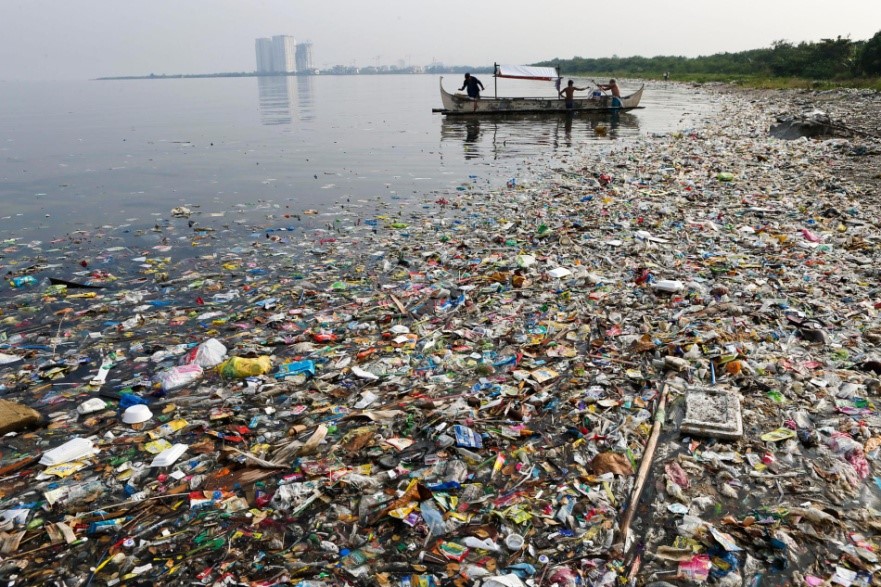In terms of today´s #EducationDay we do the unusual- it is not the ocean navigator´s team speaking but the 11th grade of the Hans – Brüggemann Schule in Bordesholm. During the first semester of their English class they dealt with the topic “Global challenges” and adressed different topics such as global warming, water shortage, fair-trade and plastic pollution in the ocean. Due to a strong interest in marine plastic pollution, their teacher reached out to the Cluster of Excellence Future Ocean for a lecture and more details, facts and figures to continue with. Based on their preparations, the lecture & discussions and additional information from the Ocean Atlas, each one wrote a blog entry on how we can contribute to saving the oceans for our future.
Starting today on “Education Day”, we will publish the best student- graded blog entries written in class during the upcoming weeks. Stay tuned and let´s hear what they have to say!
Blog Entry #1 How plastic destroys the ocean
In our current generation, we hear more and more about sustainability and the problems of our plastic consumption. Especially in school, I learn a lot about the endangerment of the ocean and sustainability. But why are these topics so popular at this time?
This has several reasons but the endangerment of the ocean bothers me the most. I have read that we are producing more than 300 million tons of plastic each year and eight of them arrive in the ocean yearly. This is a danger for every one of us and for all sea creatures.
The thing, that makes plastic so dangerous is that plastic decomposes to microplastic. These are tiny pieces of plastic that are everywhere all around the ocean. Experts estimate that there isn’t a square meter in the ocean in which there is no plastic. The reason which makes the microplastic so dangerous is that plankton absorbs pollutants of the plastic and plankton is the main food of a lot of species in the ocean. But the microplastic also just gets in the creatures in other ways. At April 2018 a whale stranded on the coasts of Spain. 29 kilograms plastic were found in the stomach of the whale. This is just an example of how much plastic is in our ocean and how extremely it affects the marine life. A problem which arises is that we take this plastic to us every time we eat fish or seafood.
I think these are enough facts to understand the extent of the usage of plastic.
An interesting question for me is also, where does all this plastic in the ocean come from? The plastic arrives via rivers in the ocean because they are direct connections to the ocean. But also via beaches. This happens mainly in southeast Asian countries like Indonesia or the Philippines in which the garbage disposal systems are too overwhelmed or underdeveloped. The result is that the plastic is disposed at the beaches or in the rivers. But not only these countries are responsible for our problem. Almost everyone has to take the responsibility too. On average, every German consumes about 37 kilograms of plastic each year. You and I are consuming plastic every day. It starts at the purchase of single-use products or plastic packed products and goes to a consumption of plastic the most people didn’t know about.
For example in a lot of kinds of toothpaste or peelings is plastic which gets via the sewage in the oceans because it’s too small to get filtered in treatment plants. Likewise are synthetic fiber textile. This is a point we have to know about because of every wash, 2000 little fibers get into the water which are too small to get filtered.
But what can we do to counteract the problem? You and I are able to do something and if everyone changes just some little things in his or her lives we can make a big difference. Just think about how many plastic bags you use, how many coffees to go you order. You can’t remember right?. It starts at shopping. You can stop using plastic bags and use cloth bags instead of it. But also we can buy glass bottles instead of PET bottles. Another point is that we have to take care of how much plastic packed products we buy. Instead of this, we can go to no waste shops where you can take your own box or bag with you and buy single unpacked products. As you can see it needs just little things and I’m sure if you and I take care of these little things we can start a chain reaction.
But also the state has to do something. My suggestion would be that a plastic tax will be introduced which makes the purchase of plastic unattractive and the revenue could be used to support projects of the marine cleaning.
All of this has to happen soon because our ocean and the marine creatures are in danger. If nothing happens, things could happen that not even experts can predict.
This project on “Global Challenges” was initiated and carried out by Imke Freymuth, Teacher at Hans-Brüggemann Schule, Bordesholm, with her 11th grade Englisch class. The project was supported by Dr. Frederike Tirre, responsible for Exhibition Management & Social Media in the Cluster of Excellence, “The Future Ocean”.
For further information or requests you can contact:
ftirre@uv.uni-kiel.de
